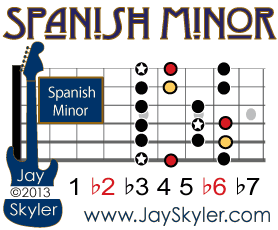Diatonic Modes on Guitar: Theory and Application (AKA Major Scale or Church Modes)
by Jay SkylerGuitar Theory: Songwriting and Improvisation
Diatonic Modes AKA Church Modes
Scales vs. Modes
All of these scales have the same notes, and therefore the same pattern on the fretboard. They are really all the same scale, yet in each case one of the seven different notes has been made the root note (or main note) of the scale, giving them a much different sound from each other.
The simplest way for guitarists to think about it is:
The Scale = the fretboard pattern
The Mode = which note is the root, which sets the Key of the song
The key of the song will be the same as the root note of the chord the song ends on. You will notice all of these diagrams are the same scale (fretboard pattern) yet a different note is starred to indicate the mode ( which note is being made the root note).
The 7 Diatonic Modes:
(aka Major Scale or Church Modes)
The Catholic church and greek city-states:
Diatonic Modes |
|
|
Greek City Name |
Common Name |
The names for the modes come from Catholic Monks who, hundreds of years ago, named the modes after the ancient Greek city states.
Many websites and even some method books claim the Ionian mode (Major Scale) was the original master scale and all the other modes are derived from it. This is not true. The original mode was the Lydian mode, the Major scale was formed by flatting the fourth note of the Lydian, because it was difficult to harmonize (so frustrating they nicknamed it 'the devils tone'). It is simply easier to think of Ionian as the master mode in order to understand modern harmony.
Common Names:
I have included the common names of all of the modes, as they actually give you some clue to the sound and usage of them. I personally usually use the common folk music names as I'm less concerned with impressing people with jargon and more concerned with understanding and teaching music.
Minor Diatonic Modes:

The three minor modes are: Aeolian Mode (really Natural Minor), Dorian Mode, and Phrygian Mode (really Spanish Minor).
Major Diatonic Modes:
The two major modes are Ionian (Major Scale) and the original Lydian. Lydian is a common choice to play over Major 7th chords in Jazz, as its raised 4th scale degree is considered less dissonant than the natural 4th in Major.
Dominant 7th Modes:
There is only one Dominant mode, the Mixolydian (aka the Dominant 7th scale). Used in Jazz extensively, and is more or less the mode of choice for meandering Zappa inspired "funky jam band noodling".
- Details
- Written by Jay Skyler
https://www.jayskyler.com
JaySkyler
Guitarist, Vocalist,and Guitar Instructor, Guitar Teacher Guitar Lessons with Jay Skyler - Category: Guitar Lessons San Francisco: Theory
The articles and diagrams on this site are provided free for personal use, without ads, and no personal information is collected or sold. If you have found this information valuable, please consider making a donation of any amount at https://paypal.me/JaySkylerGuitar Thanks! Jay Skyler
The charts and articles on this site are 100% my original copywrited writing and artwork. They may not be reproduced or modified without express written permission from Jay Skyler. They may not be linked to any site except www.JaySkyler.com. I file copyright claims with any platform they appear on if these terms are violated.